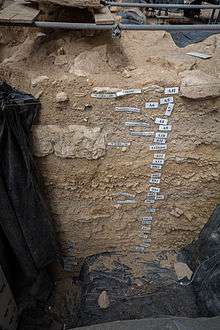Uluzzian
The Uluzzian Culture is a transitional archaeological culture between the Middle paleolithic and the Upper Paleolithic, found in Italy and Greece.


It has been dated by Katerina Douka as lasting from 45,000–39,500 years before present (BP);[1] sometimes the date range 45,000–37,000 is given, bringing the Campanian Ignimbrite eruption (37,330 BP) into the picture.
Geographical extent: In Italy: Apulia (the Grotta del Cavallo and the Uluzzo cave), Basilicata, Campania, Calabria, Tuscany, and Fumane (the northernmost point).[2] Outside of Italy, only in Argolis, Greece (the cave of Klissoura).[3]
Discovery

Excavations by 1963 Arturo Palma di Cesnola of the Grotta del Cavallo ("Cave of the Horse") in southern Italy uncovered the first remains later called "Uluzzian".[4] The cave is on the Salento peninsula in Apulia, overlooking the Gulf of Taranto. The only human remains were two deciduous teeth (Cavallo B and Cavallo C) from the Uluzzian deposit of Grotta del Cavallo identified as human by (Benazzi et al., 2011).[5] These teeth, dated to 43,000–45,000 BP, are the oldest currently-known remains of modern humans in Europe.[5]
Middle to Upper Paleolithic transition

The Uluzzian is one of several techno-complexes considered to be "transitional assemblages": Uluzzian, Châtelperronian, Szeletian, and Lincombian-Ranisian-Jerzmanowician.[6]
Culture
The Uluzzians made and used beads from shells of marine molluscs such as scaphopods, snails (Columbella rustica, Cyclope neritea), and other species.[1]
See also
References
- Douka, Katerina; Higham, Thomas FG; Wood, Rachel; Boscato, Paolo (2014). "On the chronology of the Uluzzian" (PDF). Journal of human evolution. 68: 1–13. doi:10.1016/j.jhevol.2013.12.007. Retrieved April 26, 2020.
- Peresani, M., 2012. Fifty thousand years of flint knapping and tool shaping across the Mousterian and Uluzzian sequence of Fumane cave. Quaternary International 247, 125–150
- "Klissoura cave" often appears in the literature, but the archaeologists themselves use the spelling "Klisoura" or the phrase "Cave 1 in Klisoura Gorge (Western Peloponnese)". Koumouzelis, M., Ginter, B., Koz1owski, J.K., Pawlikowski, M., Bar-Yosef, O., Albert, R.M., Litynska-Zajac, M., Stworzewicz, E., Wojtal, P., Lipecki, G., Tomek, T., Bochenski, Z.M., Pazdur, A., 2001. The early Upper Palaeolithic in Greece: the excavations in Klisoura[[{{subst:DATE}}|{{subst:DATE}}]] cave. J. Archaeol. Sci. 28, 515–539.
- Palma di Cesnola, Arturo (1964). "Seconda campagna di scavo nella grotta del Cavallo". Riv. Sci. Preist.: 23–39.
- Benazzi, Stefano; Katerina, Douka; Fornai, Cinzia; Bauer, Catherine C. (2011). "Early dispersal of modern humans in Europe and implications for Neanderthal behaviour". Nature. 479 (7374): 525–528. doi:10.1038/nature10617. Retrieved April 26, 2020.
- Hublin, J-J. (2015). "The modern human colonization of western Eurasia: when and where?". Quaternary Sci. Rev. 118: 194–210.